|
Steelhead School Presents
Ohio Steelhead Fishing
History in the Making
By: Don Dfishinfool Mathews
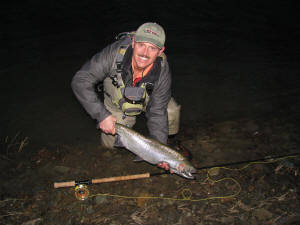
Don with a fresh March steelhead caught on an un-stocked
Ohio tributary.
In my younger days there were very few steelhead to be
had for a kid living in Ohio. Pennsylvania had
been stocking a few steelhead since the early 60's.
Ohio was still experimenting with Salmon and hadn't
started stocking steelhead yet.
Steelhead are not Native to the Great Lakes.
They were
first stocked into Lake Erie around 1900. Since then there has been a
small population of wild fish. Most of these wild
fish reside in the cooler Canadian streams on the North
side of the Lake. A few of these wild
Canadian fish stray to our streams, but not many.
My first Ohio steelhead came from Conneaut Creek. You
see Conneaut creeks head waters are in Pennsylvania.
They stock put and
take trout in the upper stretches of Conneaut creek.
When the stream warms up in June these stocked trout are
forced to migrate to Lake Erie in search of cooler
water. Three years later these put and take trout reached sexual
maturity and come back to spawn. To beat the odds
they faced and make it back to spawn meant these fish
were true survivors. They are few and far
between. In my youth we knew them as Lake run bows.
Every one was a trophy..!!
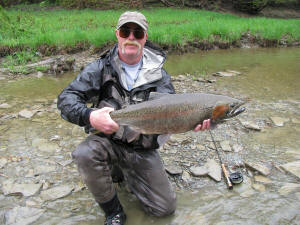
Guide Jeff Novak Shows off a late spring Manistee caught
swinging flies on Ohio's Conneaut Creek
In the late 70's I was a young teenager who spent my
summers in the Conneaut and Ashtabula areas. On
occasion I found
work first mating, cleaning fish and puke on the areas
Walleye Charter Boats. My uncle Pete Mathews ran
the charter boat "Sin or Swim" and I spent a lot of my
time on his boat. This was the good old days
of our Erie Walleye fishery. Limits were easy and
the guests were always smiling.
I have
always loved fishing Lake Erie's waters but I have a
thing for our area streams. In those days I spent my winters
trapping the Grand, Cuyahoga, Ashtabula, and Conneaut creek
watersheds. Muskrat, Mink, Coon and
Beavers all fetched a good price and I did well for a
kid. I loved the streams and spent all the
time I could on them. In the fall you could often find me and
my buddies floating the Grand or Conneaut in our Canoes.
We hunted ducks, deer, squirrels and whatever else
we could find along the riverbanks.
If you
would have told me then that one day I would make my
living fishing these streams. I would have looked
at you like you were crazy.! You see
there were very few fish in our streams back then.
If I caught a Lake run bow it was cause for celebration.
I would string it up and show it off all over town.
The state was experimenting with stocking Salmon in
those days. We did catch a few Salmon in the fall
but the returns were poor. Lake Erie didn't have
the Alewives baitfish like the other great lakes.
Salmon just never did well in Erie. For the most
part we caught Catfish, Smallmouth and Suckers. On
rare occasion the Grand would give up a walleye or two
if you were lucky.
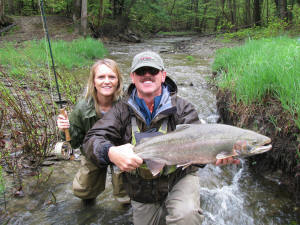
My wife caught this late spring Ohio Manistee in May on
Conneaut Creek
One fall day myself and a couple of buddies were fishing
under the High Trestle Bridge in Lower Conneaut in hopes
of tangling with a big King salmon. As usual we
were catching nothing. Along comes old
Curtis Knightlinger. He sets up directly across
the river from us. Even in those days Kurt was
old. Especially to a kid who didn't have his
drivers license yet. Kurt owned the local bait
shop in town. Old Kurt had a slow methodical way
about him. He never hurried anything.
That day after about 30
minutes of fussing with his gear he makes a cast.
The ripples from the splash hadn't even disappeared when
suddenly the water erupts in Silver. Old
Kurt fights the the silver trout in and reaches down and
unhooks it. I watched in disbelief as he let it
go. Surely this old man has went crazy letting a
fish like that go. I watched with amazement
as he repeated this five more times. Six lake run
bows in one day, heck that was more than I had
caught in all of the previous year. I just had to know what he
was using for bait. So we talked my buddy Rich
into casting across old Kurts line to discover what the
magic bait was. Of course this pissed off
Kurt who knew what we were up to. He yells
out You little Sons of !@#$@, don't you dare
tangle up my line again, come on over here if you
want to find out how to catch them. That afternoon
I sat and listened. I learned about light line,
floats, black jigs and maggots. Soon after I was
fighting a big silver hen. Kurt also told us how
these fish didn't die after spawning like the Salmon.
I learned the importance of letting them go.
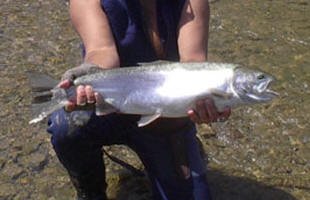
A fresh from Lake Erie Ohio Manistee Strain Steelhead or
"Chromer". Notice the silver color. This
fish has not got it's spawning colors yet. Fish
will start to change colors about one week after they
enter the stream. Judging by the size this fish is a
repeat spawner. Meaning it has survived previous
spawning runs.
Sure I had caught steelhead before, but it was on this day
that I became a Steelheader. Kurt passed
away about three years ago and he is missed by many.
The knowledge he shared with me and many others lives
on. In my youth, I spent many days just hanging
out at his bait shop. It was there that I
learned about, curing eggs, tying egg sacs, salting shiners and
all the other odd tricks Kurt had up his sleeve.
Little did I know Ohio steelheading was in for a big
change.
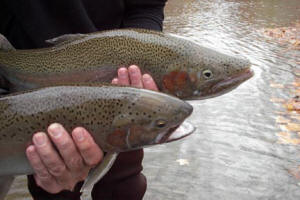
Both of these fish are typical first run fish (3 yr old)
appx 22-24 inches long. Both fish are in their spawning
colors. Notice the hook or kype on the bottom jaw of the
top fish. This is a male or buck. The males also
get a red or crimson cheek and stripe down the side when
in the streams. The bottom fish has no kype and a
more rounded nose. This is the female or hen.
Notice the white mouth and gums. This is typical of all
steelhead. Salmon will have black mouths or gums.
These fish will loose their spawning colors and turn
silver when they return to the lake.
Ohio is the new kid on the block when it comes to
trout fishing. They started to stock fishable
numbers of Steelhead in
the Early 80's. Trout fishing has a long heritage
in Pennsylvania but in Ohio we lack the cold water
streams necessary for a year round trout fishery.
People definitely do not associate Ohio with trout
fishing, even though our steelhead fishery is
booming..!!
The reason for our success is the wisdom of the Ohio DNR and
the abundant forage in our shallowest of the great
lakes. It is my honest belief that Ohio will soon
be known as the premiere Steelhead destination in the
Great Lakes region.
You see Ohio has something
that Pennsylvania lacks. ACCESS.... We have lots
and lots of miles of river flowing into Lake Erie.
Our forefathers here in Ohio were very wise.
Thanks to a large network of State and local parks we
have many miles of public access to our streams.
In Ohio we have more unobstructed river miles flowing
into Lake Erie than Pa, and Michigan combined.
Pennsylvania on the other hand has a small handful of
very short streams that are almost entirely privately
owned. Angler crowding is becoming a big problem
in Pennsylvania. So far the landowners in all of the states
have been very tolerant of the crowds of anglers but I
fear it is reaching a breaking point in Pa.
Already we have groups leasing the streams in an attempt
to privatize the fishery. It seems like every day
I hear about another section of stream being posted or
closed to fishing. The situation in Pennsylvania
worries me. I find each year I do fewer and fewer
guide trips in Pennsylvania. BUT
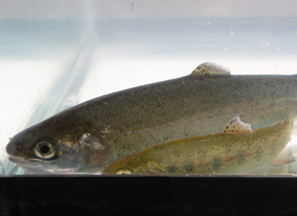
Pictured are two young Ohio Manistee strain steelhead.
Notice the lower fish still has it's par markings and is
in the smolt stage of it's life cycle. The top fish has
just left its smolting stage. The top fish is about 9
inches long. These are the typical size of the
fish Ohio stocks each spring
The steelhead fishery in Ohio is coming of age.
We trade Channel Catfish fingerlings to Michigan for
Steelhead smolts and eggs. Michigan gets these
eggs from the Little Manistee River Weir. The fish
in the Little Manistee are a self sustaining wild
population. The Michigan streams are cold enough
year round to support natural reproduction.
Unfortunately here in Ohio our stream temperatures do
not allow the fish to successfully reproduce. Our
fish do spawn but the fry die shortly after hatching due
in large part to our stream temperatures. Virtually all of
our fish in Ohio and Pa are stocked by the states.
Our streams are some of the most densely stocked streams
in the world. Pennsylvania stocks close to 1.5 million
6-9 inch long smolts each spring. Ohio stocks
400,000 in her streams. The survival rate of these
implanted smolts is very good. It is considered a
success If 10% of the smolts reach adulthood and return
to the stream. One Pennsylvania study had close to
50% of the fish returning. This is almost
unbelievable and shows how well Pennsylvania understands
the Steelhead game. Of course Pennsylvania has
over 100 years experience raising trout.
Ohio is
making great progress with their steelhead program. Our
DNR seems genuinely committed to making continuous
improvements to our steelhead program.
Stocking steelhead is a costly and the states
have appx $1 in each stocked smolt.
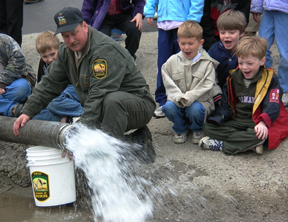
Here a group of excited school children watch as the
steelhead smolts are stocked in the Vermillion River in
Ohio. The fish were raised at Ohio's Castalia facility.
The Ohio DNR stocks appx 65,000 Manistee smolts in the
Vermillion River each spring
Once a steelhead reaches maturity it returns to the
stream it was implanted in to spawn. They
locate their home stream by smell. Our steelhead
smolts do not have a long time to acclimate to the
stream before warming spring water temperatures chase
them to the lake. It is my belief that this is why
so many of our Ohio fish stray. This is a good
thing in my opinion. It helps to spread the
fish out to un-stocked streams.
When I say our fish stray, what I
mean they make a mistake and run up different
river than the one they were implanted in. Simply put
some of our smolts do not spend enough time in the
stream to acclimate. This seems to be especially true in
Ohio. Pennsylvania has figured out that
stocking fish in the upper sections of the stream helps
prevent straying.
Many of the Pennsylvania smolts
are stocked in the far upper sections of the streams.
In Conneaut Creek the Pa smolts are stocked about 45
miles from the Lake.
Ohio on the other hand stocks their fish near the stream
mouths. This does help keep the smolts from
becoming unintentionally caught by anglers in the upper
river. It is my belief this is the reason several
of our our un-stocked Ohio streams get such a prolific
runs.
Year after year I track where the
trucks dump the smolts into the streams. Let me
tell you the majority of fish comeback to the exact spot
they were implanted in. On the Pennsylvania
streams there are noticeably less fish upstream of the
point the trucks put them in at. Its a sure bet
there will be a good pod of fish near where the trucks
stock the fish. This is why I so carefully keep
track of where the fish are being stocked.
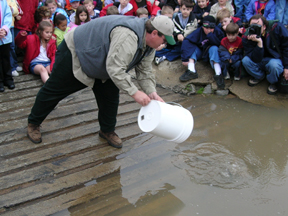
I may have already caught a few of these fish I helped
stock in the spring of 05 in the Vermillion River.
Our Manistee Strain Ohio fish tend to run much later
than their Pa and NY cousins do. This is because
of their Genetic lineage. Their parents are from
the little Manistee River in Michigan. It stays a
cool temperature year round. Most fish in the
Little Man tend to spawn in Late April or Early
May. It only makes sense that their offspring will
tend to spawn at the same time. This is why most
steelhead veterans consider the Manistee to be a spring
run fish.
Our Ohio fish will start to enter the
streams in Late November. They will continue to run and
will holdover all winter. The bulk of the Ohio run
will happen in Early March most years. The fight
of our wild Manistee strain fish is terriffic.
Years ago
Ohio used to stock London Strain fish. They were a
fall run fish. There were several problems
with the London's so Ohio decided to stock 200,000
Manistee Strain Fish in 1996. Ohio soon
discovered that the return rate was much better
with the Manistee strain. Now have switched to a
Manistee only program.
At first I was upset. I
feared the fall fishery would disappear in Ohio.
As I predicted the catch rate for the Fall month's in
Ohio went down. I discovered that there were
enough fall run strays from Pa and Early run Manistee to
make fall fishing Good for most of the fall. It also
helps that Pennsylvania is stocking Conneaut Creek with
it's fall run fish. I will admit the more I
get to know the Manistee the more I like them. Its
nice having fresh fish around in the spring, plus their
wild genes show in the fight they give on the line.
The mighty Manistee has earned my respect.
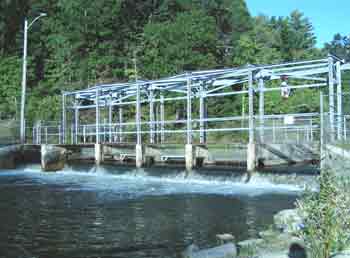
Little Manistee River weir in Michigan. This cool
running stream is home to a population of wild fish.
This is where Ohio gets their steelhead eggs from.
Ohio stocks five of it's streams with Steelhead.
Conneaut, Grand, Chagrin, Rocky, and Vermillion.
All of these streams receive appx 65,000 smolts each
spring. Conneaut Creek also receives
75,000 fish from Pennsylvania. This makes Conneaut
unique, it gets both spring and fall run fish.
Many Ohio streams that do not get stocked get good runs
of fish each year. Ashtabula, Cowels,
Wheeler, Arcola, Euclid, Cuyahoga, Black, Portgage,
and the Huron River all receive runs of Steelhead
strays. There are dozens of smaller streams or
ditches that are worth mentioning also but I will not
for obvious reasons.
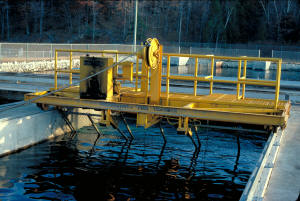
Automated equipment makes fish collection easy. When the
weir gates are raised, river flow is diverted
through holding tanks. Fish swim into the tanks
where overhead cranes and nets collect them.
If one were to compare the number of fish stocked per
stream mile between Ohio and Pennsylvania, it would seem
like Pa is the place to fish. This can be true, at
times there are unbelievable numbers of fish in Pa.
This is why I continue to shell out the $400 non
resident guide license fee each year. There are several
other factors to consider though.
Angler crowding
in much worse in Pa. Unless there is a blizzard
you can forget the weekends. On the other hand one
willing to do a little walking in Ohio can always find a
section of stream to himself.
A recent study done
in Pa shows one in three steelhead that is caught is
kept. This is bad news for steelhead.
Believe it or not most fish are caught repeatedly
through the season. Some winter holdover fish are
caught and released dozens of times. Sooner or later
most Pa steelhead end up that one out of three.
This means all these kept fish will not survive to
become a repeat spawner.
Less repeat spawners is
not a good thing. We will
get back to that later.
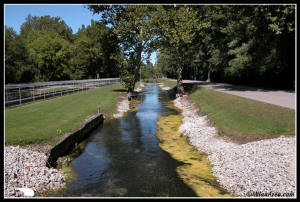
Castalia fish hatchery in Ohio. This is where Ohio
steelhead spend their first year.
In Ohio on the other hand far fewer fish are
kept. The limits are lower but that doesn't seem
to matter. I really can't explain why this holds
true. I honestly believe that people in Ohio
just don't have a taste for trout like they do in Pa.
Maybe its because of the abundance of Erie caught perch
and walleye in my freezer. I personally never eat steelhead.
Most locals around here don't have much trouble catching
perch. If you have never ate Lake Erie perch your
missing out.
Another reason few fish are creeled in Ohio
might be because of the work involved. If your hiking miles into
the Grand River in Ohio who in their right mind is going
to lug a adult steelhead out of there? In
all honesty I don't know why less fish are kept in Ohio.
The fact that less fish are kept means
there are more repeat spawners in Ohio
than in Pennsylvania. If your into big steelhead that's a
good thing, trust me..!!

A 15 lb Ohio repeat spawner taken on the lower river.
For our steelhead to get this size they must survive
several spawning runs.
A steelhead reaches maturity at three years of age.
They spend their first year in the stream as fry and
then fingerlings. At one year old they migrate out to
Lake Erie. They spend their time in lake
Erie gorging on Shiners, Smelt, Shad, Gobies, Mayflies,
spinney water fleas and other high protein food sources.
Their growth rate is far faster than a stream trout
living on a diet of nymphs.
When they return to
the stream as three yr olds they are 22-24 inches long.
If they are lucky enough not to end up on a rope or a
fatality of weather they return to the Lake. We
call them drop backs as they hobble back to he Lake
after the rigors of the spawn. They are dark
and beat up with wounds from fighting and digging in the
gravel.
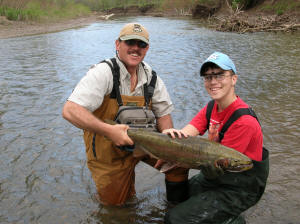
Male Steelhead like this Vermillion River 13 lb drop back warrior, spar
with other male fish for breeding rights. They
bite and slash at each other often causing wounds or
sores. It is not uncommon to see beat up males
during the spawning season.
After spawning the hens quickly return to the Lake.
Most male fish remain in the river until late spring
waiting for more hens to show up. This is why
there are almost always more male fish than female fish
in the streams. Eventually the water temperature will
warm to the point the Males will be forced to return to
the Lake also. Once the fish return to Lake Erie
they will rejuvenate. They will loose their
spawning colors and turn silver again. The Males
Kype will shrink and their battle wounds quickly heal in
the cool Lake waters. By the fourth of July they
are completely transformed back into Chromers.
They will spend yet another summer in Lake Erie feasting
on its abundant forage until the urge to spawn draws
them back to the stream.
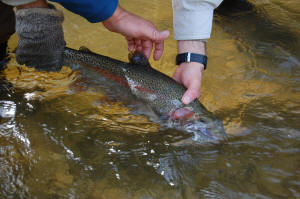
DNA testing is the only sure way to distinguish between
different steelhead strains. One good indicator of
a Ohio stocked fish is a fully developed dorsal fin.
Pennsylvania crowds their smolts in the raceways.
This close contact with each other wears their dorsal
fins down. This doesn't seem to happen with the Ohio
smolts.
The larger fish in the stream are repeat spawners.
Meaning they have survived a previous spawn and have
returned to spawn again. Being fishermen most of
us want to catch the biggest fish possible. On
Steelhead Alley this means finding repeat spawners.
I fish sections of the Grand River from my drift boat
that I have never seen another soul fishing. The
odds of anyone keeping a fish there are slim. Logic
tells us that the odds of finding repeat spawners in
such places is far greater. The average size of
the fish is much larger on the Grand River than most
streams on the Alley.
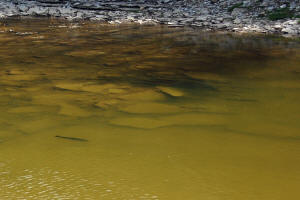
A pod of fresh run fish in Conneaut Creek during low
water conditions in April
A friend of mine named Jimmy Dallas has been involved
with 3 CU's and the Pennsylvania steelhead program since
it's beginning in the early 60's. Jimmy has
forgotten more about steelhead than most of us will ever
know. One theory of Jimmy's is that the
larger fish generally come from the lower sections of
stream. He believes that the biggest of big fish do not
run very far up the streams instead they quickly spawn in the lower
rivers then head immediately back to the Lake. I totally
agree with this theory. I see far more large
repeat spawners in the lower river than the upper
sections of stream. Jimmy's reasoning for this
phenomenon is that the fish remember from previous runs
that there are lots of anglers upstream and little good
spawning gravel. I personally have seen about
twenty fish over 15 lbs caught. All but one came
from the first three miles of the stream. If your
targeting big fish this is something to keep in mind.
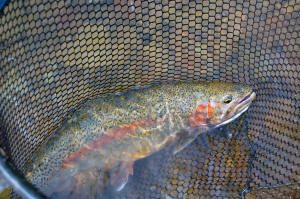
A nice Ohio buck steelie that was released to fight
again.
What will the future bring to our fishery?
Stream Access, Pollution, VHS infections, Zebra
mussels, Gobies, Many real threats to our
steelhead program exist right now. I have
faith in our current Ohio DNR leadership. I
think they are on the right track. With a little
luck our children will get to catch more steelhead in
Ohio than
I did as a youth.
Let's Go Fishin..!!
Northeast Ohio Steelhead Fishing |
OH Steelhead Fishing Guide |
OH Steelhead Salmon Fishing |
Lake Erie Fishing Guide |
Steelhead Alley Guided Fishing | Steelhead
Fishing Guide |
Steelhead Fishing Reports Ohio
|